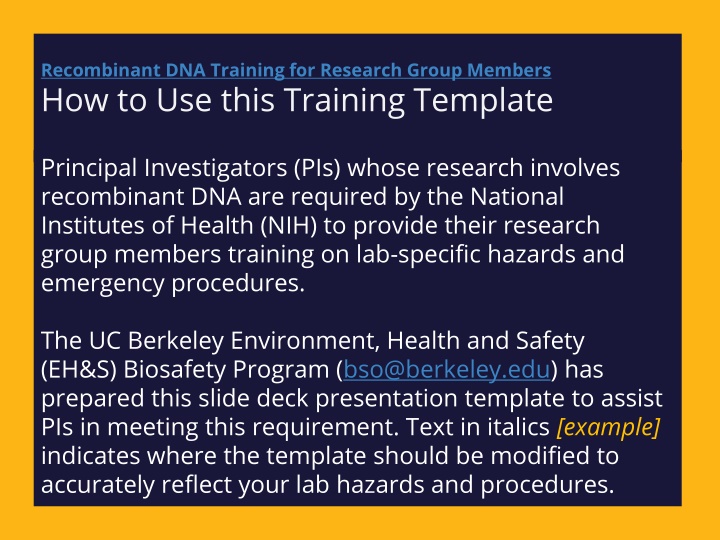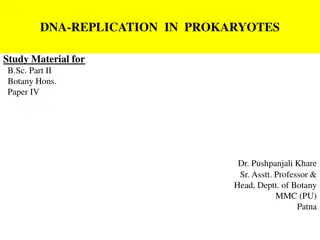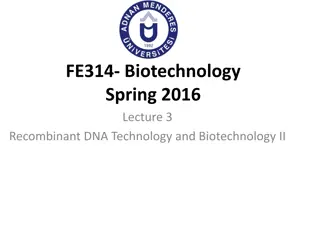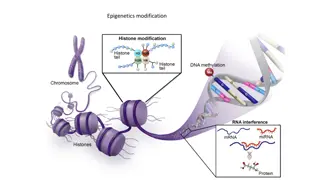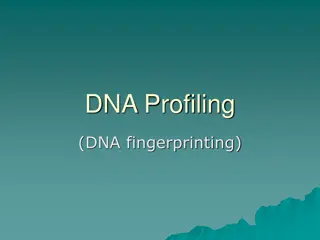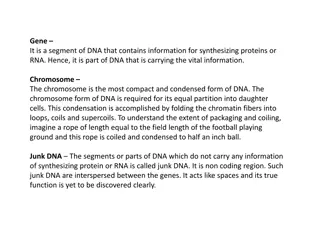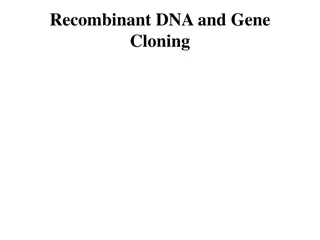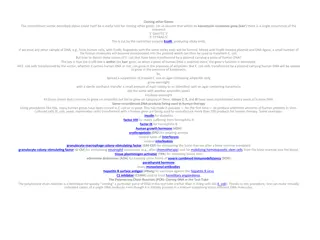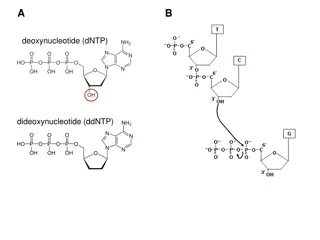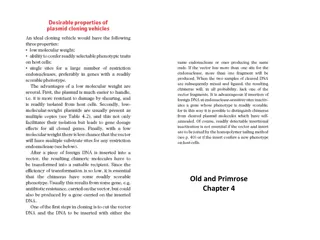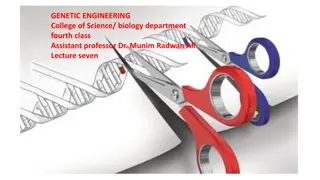Recombinant DNA Training Overview for Research Group Members
This training template is designed to assist Principal Investigators in providing lab-specific biosafety training to research group members working with recombinant DNA. It covers essential topics such as NIH guidelines, administrative requirements, risk assessment, emergency procedures, and more. Compliance with these regulations ensures safe handling of recombinant DNA in the laboratory environment.
Download Presentation

Please find below an Image/Link to download the presentation.
The content on the website is provided AS IS for your information and personal use only. It may not be sold, licensed, or shared on other websites without obtaining consent from the author.If you encounter any issues during the download, it is possible that the publisher has removed the file from their server.
You are allowed to download the files provided on this website for personal or commercial use, subject to the condition that they are used lawfully. All files are the property of their respective owners.
The content on the website is provided AS IS for your information and personal use only. It may not be sold, licensed, or shared on other websites without obtaining consent from the author.
E N D
Presentation Transcript
Recombinant DNA Training for Research Group Members How to Use this Training Template Principal Investigators (PIs) whose research involves recombinant DNA are required by the National Institutes of Health (NIH) to provide their research group members training on lab-specific hazards and emergency procedures. The UC Berkeley Environment, Health and Safety (EH&S) Biosafety Program (bso@berkeley.edu) has prepared this slide deck presentation template to assist PIs in meeting this requirement. Text in italics [example] indicates where the template should be modified to accurately reflect your lab hazards and procedures.
Working with Recombinant DNA in the _[name of PI]_ Laboratory [Name of PI] [Name of Department] [Date Training was Last Updated]
Basic Requirements Research involving recombinant DNA is closely regulated by the National Institutes of Health (NIH), and requires a Biological Use Authorization (BUA) approved by the UC Berkeley Committee on Laboratory & Environmental Biosafety (CLEB). CLEB works with the UC Berkeley Environment, Health and Safety (EH&S) Biosafety Program, which can provide additional guidance (bso@berkeley.edu).
Basic Requirements (Contd) All work involving recombinant DNA regardless of funding source - must adhere to the mandatory NIH Guidelines for Research Involving recombinant DNA Molecules found at https://osp.od.nih.gov/wp- content/uploads/NIH_Guidelines.pdf
Purpose of this Training Section IV-B-7-d-(2) of the NIH Guidelines The NIH requires that the PI provide lab-specific biosafety training on the hazards of the specific experimental procedures used in their laboratory to members of their research group.
Contents of this Training CLEB Administrative Requirements What are the NIH Guidelines? Role of the Investigator/Lab Staff Description of the Experiment-BUA The Agents Used The Template Risk Assessment/Biosafety Level Good Work Practices Personal Protective Equipment Engineering Controls Waste Disposal/Decontamination Emergency Procedures
CLEB Administrative Requirements CLEB requires the following from every PI approved to use recombinant DNA: Train all research group members on lab-specific hazards and procedures Report incidents involving recombinant DNA immediately to EH&S Submit a BUA amendment for any change in personnel or Scope of Work
What are the NIH Guidelines? Key Sections of the NIH Guidelines Appendix B - List of Agents Section III - Types of Experiments involving recombinant DNA Appendix G - Level of Containment Appendix K - Large Scale Appendix M - Gene Transfer/Human Subjects Appendix P - Transgenic Plants Appendix Q - Transgenic Animals Section IV - Responsibilities of PI, IBC
PI Responsibilities Section IV-B-7: Role of the PI On behalf of the institution, the PI is responsible for full compliance with the NIH Guidelines for any recombinant DNA research. The PI must: Not initiate or modify recombinant DNA research which requires CLEB approval until that research has been approved by CLEB and has met all other requirements of the NIH Guidelines. Report any significant problems, violations of the NIH Guidelines, or any significant research-related accidents and illnesses to the Biosafety Officer and CLEB.
Other PI Responsibilities Responsibility NIH Guideline Reference Train Lab Staff (Micro technique) Ship Agents Safely Follow Emergency Plans Notify NIH of novel host/vectors Update Protocol Notify IBC/CLEB of incident Make Protocol Available Offer Medical Surveillance Supervise Lab Members Maintain Safety Equipment Section IV-B-7-a, d Section IV-B-7-a Section IV-B-7-a Section IV-B-7-b Section IV-B-7-c Section IV-B-7-e Section IV-B-7-d Section IV-B-7-d Section IV-B-7-e Section IV-B-7-e
Description of the Experiment-BUA The Scope of Work [Cut and paste scope of work narrative from your BUA] Create additional slides if needed
Description of the Experiment-BUA The Agents Used [List the agents, recombinant DNA host/vector systems, human cell lines, packaging cell lines, and clinical specimens used in the experiment. Include all etiological agents.]
Description of the Experiment-BUA The Risks that May Affect Containment Level These are some of the common experimental risks associated with our research: [modify list as appropriate] Route(s) of exposure Volumes of culture Aerosol generating procedures Procedures involving sharps High concentrations The use of vectors and vulnerable animals Inserted genetic sequences that increase virulence The use of drug/antibiotic resistant strains
Description of the Experiment-BUA The Risks that May Affect Containment Level These are the symptoms of exposure with the agents we use: [List symptoms of exposure]
Our Recombinant DNA Experiment Template [Cut and paste from BUA form:] Agent characteristics: Routes of exposure: Host: Vector: Nature of inserted sequences: Source of inserted sequences: Types of manipulation: Attempt to express foreign gene: Protein produced: Containment: Section of guidelines:
Risk Assessment/Biosafety Level Good Work Practices [Modify list as appropriate] Wash hands frequently Use personal protective equipment and engineering controls Minimize use of sharps Do not eat, drink, or smoke in the lab Disinfect work areas
Risk Assessment/Biosafety Level Personal Protective Equipment [Modify list as appropriate] The following personal protective equipment must be worn when handling agents in the tissue culture room and the biosafety cabinet: Latex or nitrile gloves Lab coat Safety glasses
Risk Assessment/Biosafety Level Engineering Controls [Modify list as appropriate] The following engineering controls must be used whenever handling agents in the tissue culture room: Biosafety cabinet Sink for hand washing Mechanical pipettes Sealed vials Sharps containers/broken glass box Eyewash/deluge shower (use only in an emergency)
Waste Disposal/Decontamination [Modify list as appropriate] Liquid waste will be treated with bleach (10% final concentration), allowed to set for 20 minutes and drain-disposed. Solid red bag wastes will be placed in a red-bag lined bin and transferred to the _________ Building, Room______ medical waste storage area for pick up & disposal. Work areas must be disinfected with 70% ethanol,10% bleach, or______________
Emergency Procedures [modify as appropriate] In the event of a laboratory accident: Tend to injured person. Seek medical attention at Tang or the Alta Bates ER at 2450 Ashby Avenue after hours. Immediately notify the PI or the lab supervisor of the incident. Initiate clean up procedures. Notify EH&S within 8 business hours of a biohazardous spill or if recombinant DNA was involved (but immediately in the event of large spills or injury): (510)-642-3073 (510)-642-3333 (After Hours)
Conclusion This training is designed to inform you of the NIH requirements regarding use of recombinant DNA, and our lab s implementation of the NIH requirements. All recombinant DNA experiments require BUA approval by CLEB and any changes require an approved amendment to the BUA. If you have any questions on this training, let me know, and I will contact the Biosafety Officer for assistance.
Training Documentation: Please keep a record of lab members who have completed this lab specific training, include: Trainee name (first, last) E-mail Signature Date of training completion First Name Last Name email: Signature Date ___@berkeley.edu
